Setting sail on a grand ocean voyage is an exhilarating experience. The gentle sway of the ship, endless horizons, and luxurious amenities offer a unique getaway.
In this guide, we’ll unravel the secrets to finding the best rooms on a cruise ship, ensuring that your maritime adventure is both memorable and comfortable.
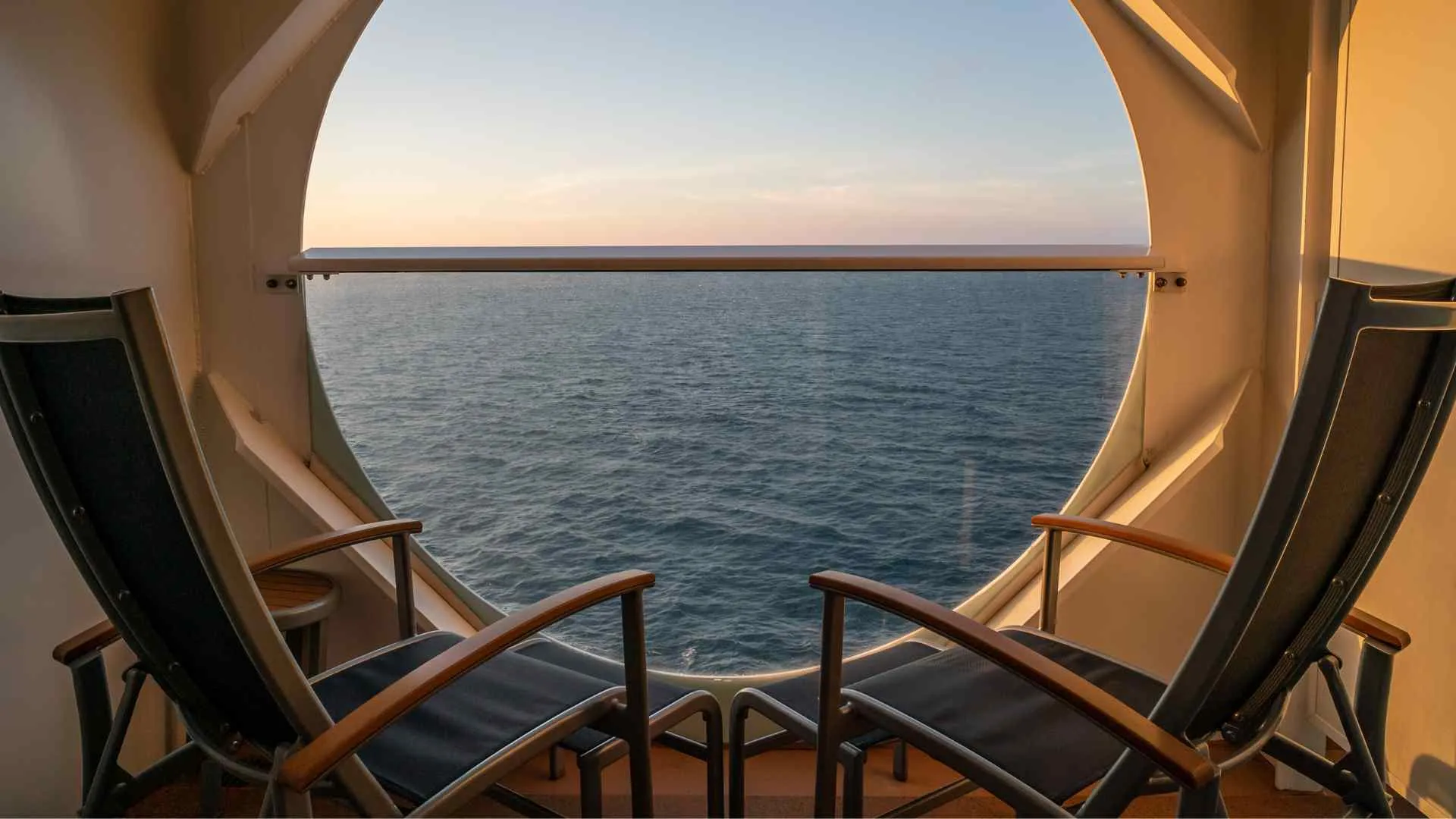
Understanding Cruise Ship Terminology
Before diving into the quest for the best rooms on a cruise ship, it’s crucial to familiarize ourselves with the lingo. Just like checking into a hotel has its unique language, embarking on an all-inclusive cruise is no different.
By understanding these terms, you’ll be better equipped to navigate ship decks, differentiate between various room types, and make an informed choice.
Differentiating Cabins, Suites, and Staterooms
The first step to identifying the best rooms on a cruise ship is to understand what each term means:
- Cabins: This is a private room on the ship, similar to a hotel room. While it can be cozy and come equipped with essential amenities, it’s often the most basic form of accommodation on board.
- Suites: A suite is a more luxurious and spacious option. These often include separate living areas, larger bathrooms, and additional perks. Suites are perfect for those looking for an upscale experience or traveling with family and need the extra space.
- Staterooms: This term is often used interchangeably with cabins. However, some cruise lines may reserve the term “stateroom” for rooms with a view or added amenities.
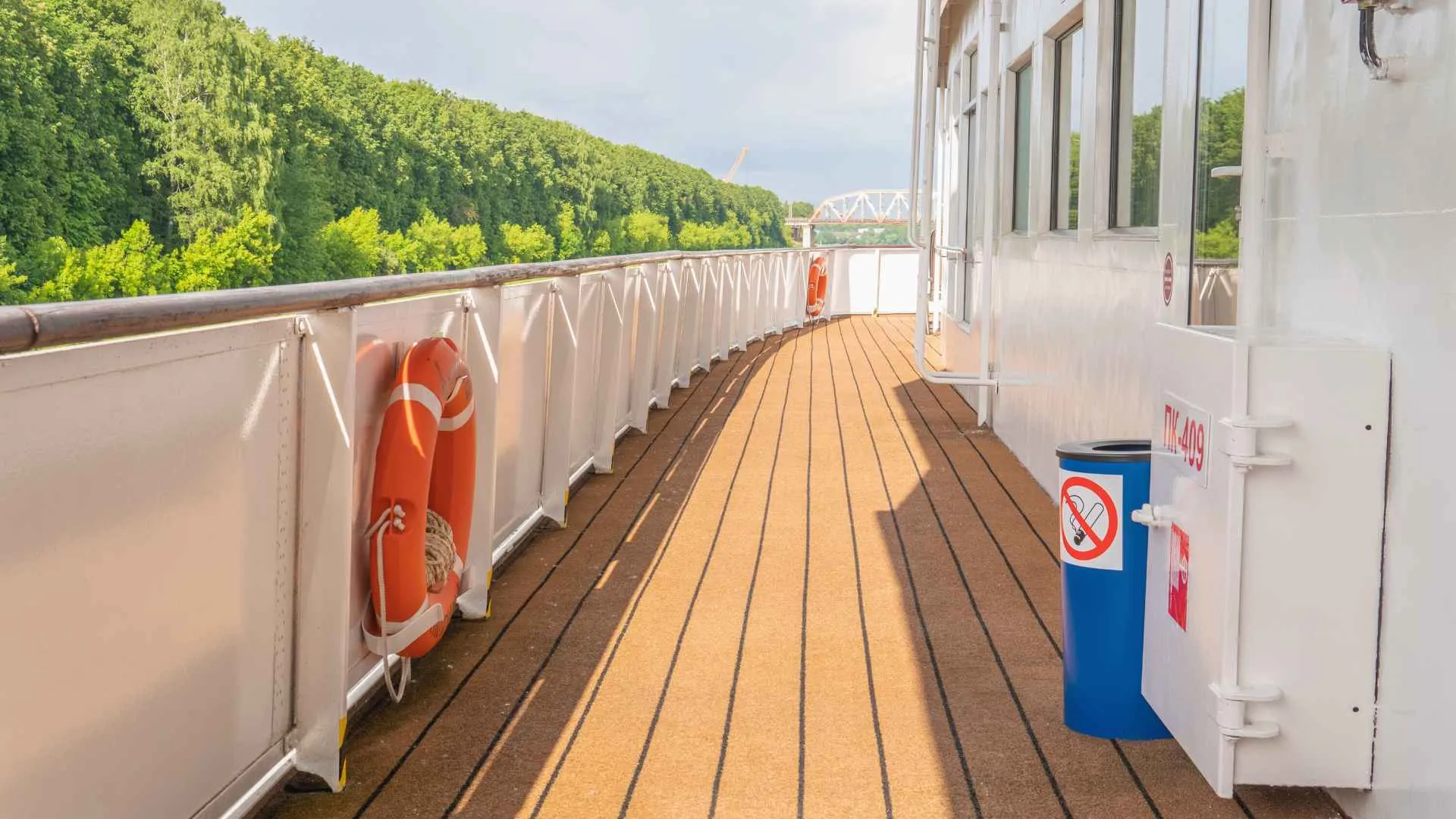
The Deck and its Importance
The deck refers to the various levels or floors on a cruise ship. The position of your room on a particular deck can greatly influence your experience. For instance:
- Lower decks can often be more stable, making them ideal for those prone to seasickness.
- Higher decks might offer better views but could also be noisier due to proximity to pool areas or entertainment venues.
Understanding the layout of the decks is crucial when scouting for the best rooms on a cruise ship.
Bow, Stern, Port, and Starboard Explained
To truly find the best rooms on a cruise ship, you should also be familiar with these navigational terms:
- Bow: The front part of the ship.
- Stern: The back part of the ship.
- Port: The left side of the ship when facing forward.
- Starboard: The right side of the ship when facing forward.
Being aware of these directions can help you decide where you’d like your room to be, based on the views you want, the amount of movement you’re comfortable with, and proximity to certain amenities.
By mastering these basic terms, you’re setting the stage for a smoother journey in selecting the best rooms on a cruise ship tailored to your preferences and needs.
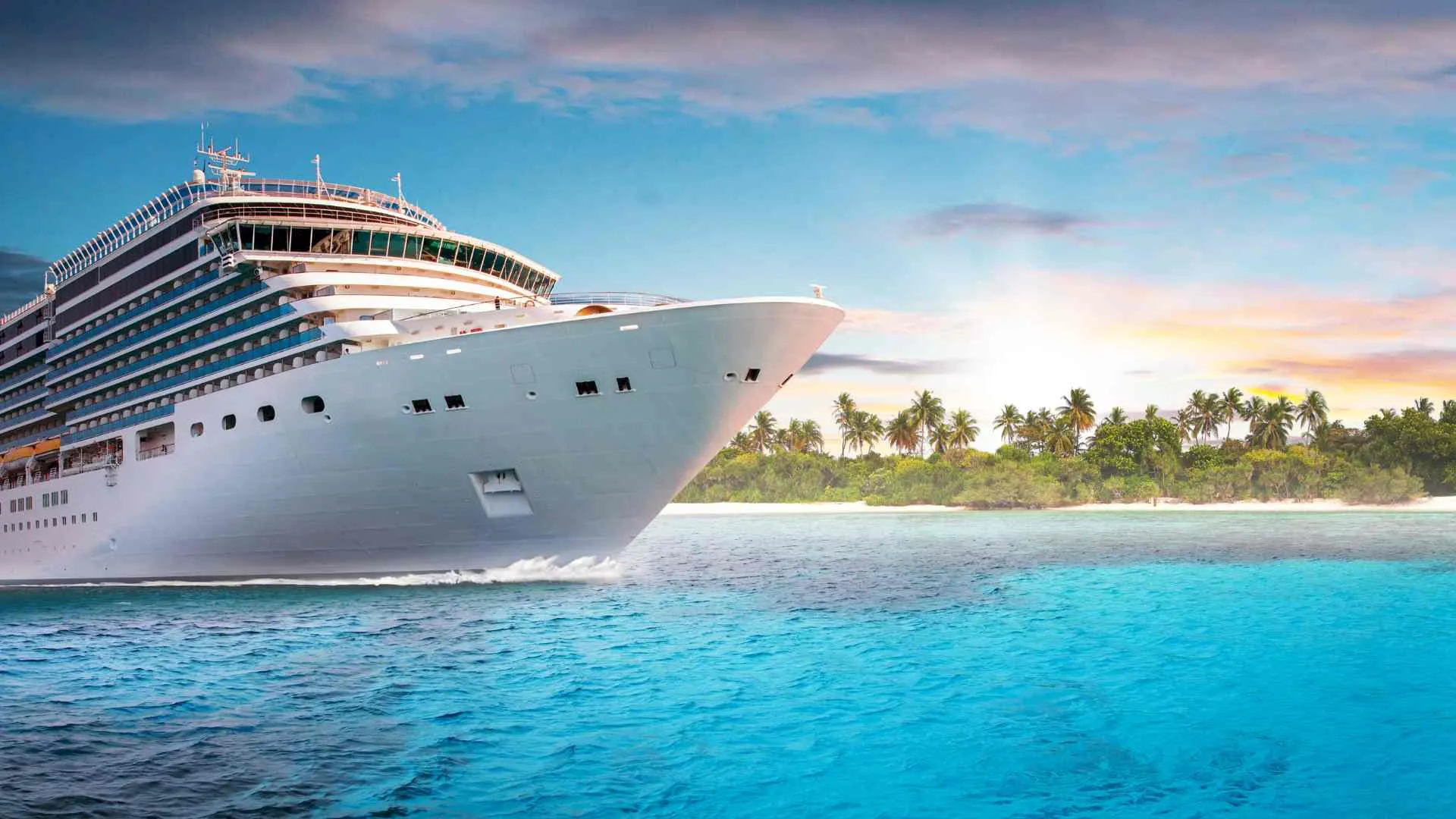
Types of Rooms
When it comes to selecting the best rooms on a cruise ship, you’ll quickly find that one size doesn’t fit all. From cozy corners to expansive cruise suites, each room type offers its own set of advantages.
Understanding the distinctions will help ensure that your chosen space aligns with your expectations and travel desires.
Inside Cabins
Definition: These are rooms without windows that are located in the interior of the ship.
- Pros:
- Often the most budget-friendly option.
- Provides a pitch-dark environment, ideal for light-sensitive sleepers.
- Generally more stable, which can be preferable for those prone to seasickness.
- Cons:
- Can feel a bit confined due to the lack of natural light.
- Lacks the outside views that many cruisers cherish.
- Best for: Budget travelers, those who plan to spend minimal time in their rooms, or passengers who prioritize sleep quality.
Oceanview Cabins
Definition: These cabins feature a window (or porthole) that offers a view of the sea.
- Pros:
- Natural light adds spaciousness to the room.
- Allows passengers to enjoy scenic views without leaving their room.
- Moderately priced, offering a balance between the inside cabins and pricier options.
- Cons:
- The windows typically don’t open, so there’s no fresh sea air.
- Some views can be obstructed depending on the ship’s structure.
- Best for: Travelers who want a glimpse of the ocean but are still mindful of their budget.
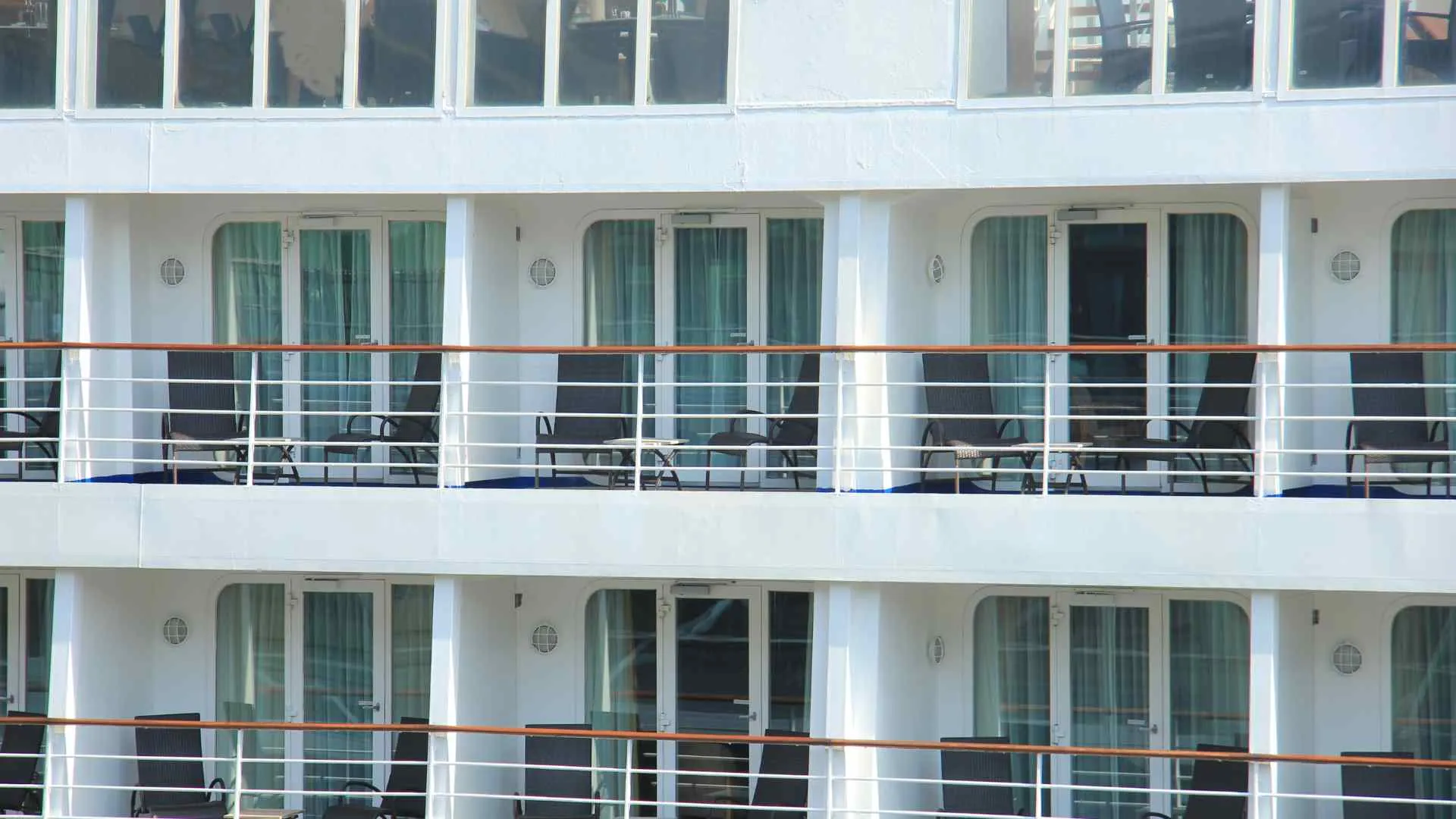
Balcony Cabins
Definition: These rooms come with a private balcony, allowing passengers to step outside without heading to the ship’s public decks.
- Pros:
- Offers personal outdoor space to enjoy the sea breeze and views.
- Great for private dining or morning coffee with a view.
- Enhances the sense of luxury and relaxation.
- Cons:
- Generally pricier than inside or oceanview cabins.
- Can sometimes be noisier if located near public areas.
- Best for: Honeymooners, anniversary celebrators, or any traveler willing to invest a bit more for an enhanced cruise experience.
Suites
Definition: The epitome of luxury on a cruise ship, suites are spacious accommodations often equipped with various high-end amenities.
- Pros:
- Larger living spaces, often with separate rooms or areas.
- Access to exclusive ship amenities or services, such as private lounges or concierge services.
- Often located in prime ship locations, offering the best views.
- Cons:
- The most expensive room option on most ships.
- Might be “too much room” for travelers who don’t plan to spend much time indoors.
- Best for: Travelers seeking a luxury experience, larger families or groups needing more space, or those celebrating special occasions.
In the vast world of cruising, your room serves as your personal sanctuary. Whether you’re after budget-friendly practicality or indulgent luxury, understanding these room types will guide you closer to pinpointing the best rooms on a cruise ship for your unique voyage.
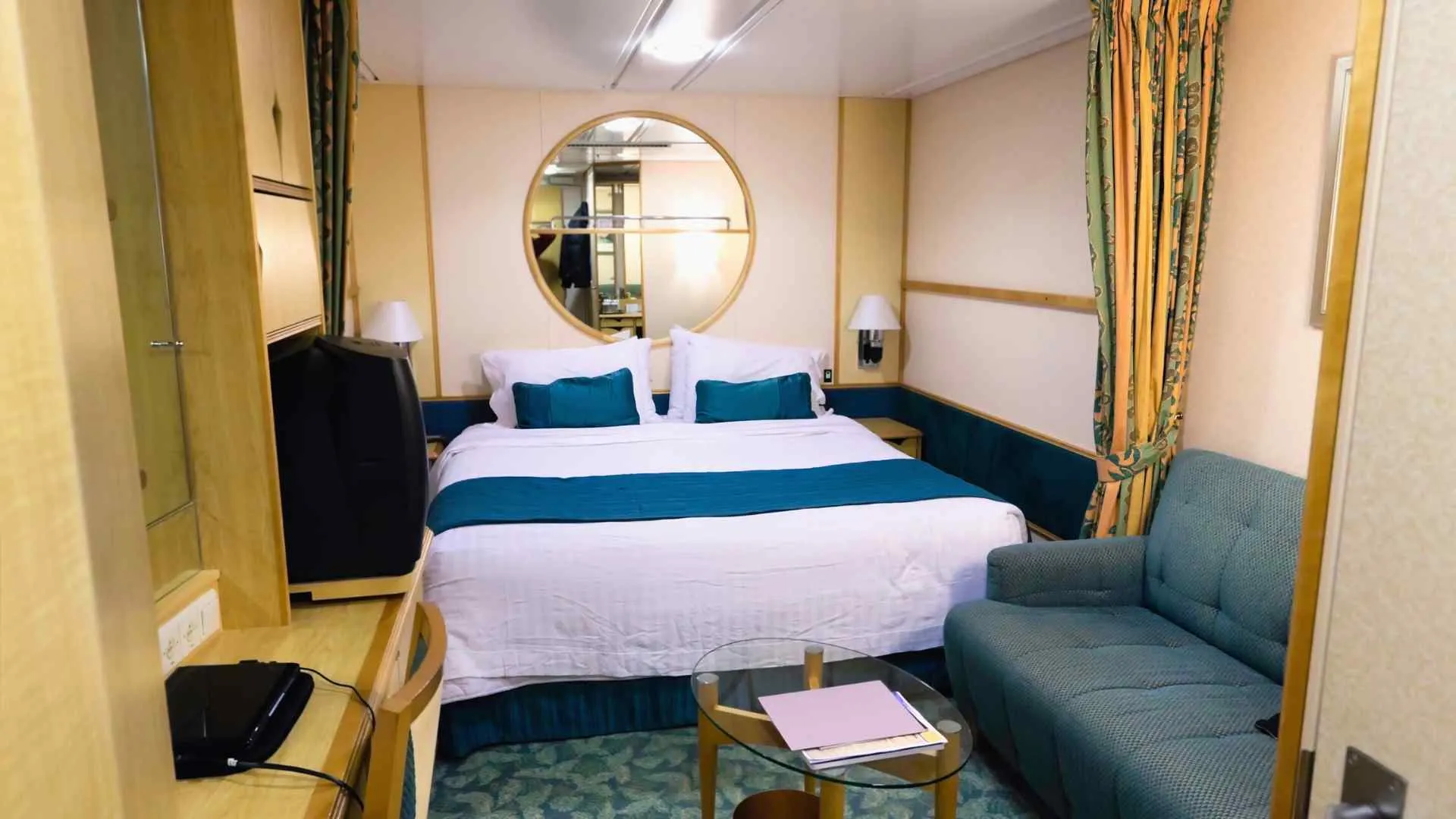
Inside Cabins: A Closer Look
Inside cabins, often the most affordable option on a cruise ship, are favored by many travelers for their budget-friendly nature. However, not all inside cabins are created equal.
Delving deeper into the subcategories and nuances will help you find the best inside cabins for your voyage.
Standard Inside Cabins
Definition: The most basic form of an inside cabin, typically featuring a bed, bathroom, and basic amenities without any additional frills.
- Finding the Best:
- Deck Choice: Choosing a mid-ship cabin on a lower deck can offer more stability, which is especially beneficial for those who are prone to seasickness.
- Proximity to Elevators: Being close to elevators and stairs can be convenient, but too close might mean more foot traffic and noise. A cabin a few doors away can strike a balance.
- What to Avoid:
- Cabins beneath busy areas, like theaters or restaurants, might experience noise from overhead activities. Check the ship’s deck plan.
Inside Cabins with Virtual Balconies
Definition: A newer concept, these cabins feature floor-to-ceiling screens that display real-time outside views, offering a semblance of an outside window.
- Finding the Best:
- Real-time Feedback: Look for reviews from past cruisers about the clarity and functionality of the screens. Some ships may offer better virtual experiences than others.
- Positioning: Ensure the virtual balcony isn’t obstructed by furniture or room fixtures.
- What to Avoid:
- Relying solely on the virtual balcony for natural light. Remember, it’s still a screen and won’t substitute for the feel of actual sunlight.
Larger or Deluxe Inside Cabins
Definition: Offering slightly more space than the standard inside cabin, these might come with a sitting area or additional storage.
- Finding the Best:
- Square Footage: While two cabins might both be labeled ‘deluxe’, they can differ in actual size. Always check the square footage.
- Layout: Some layouts can maximize usable space. Review deck plans or photos to see which suits your needs best.
- What to Avoid:
- Assuming all deluxe inside cabins have the same amenities. Always verify specific features like mini-fridges, bathtubs, or sitting areas.
When it comes to inside cabins, while they might lack external views, they offer immense value. By understanding the various options and being vigilant during the booking process, you can secure the best rooms on a cruise ship that fit snugly within your budget and meet your needs.
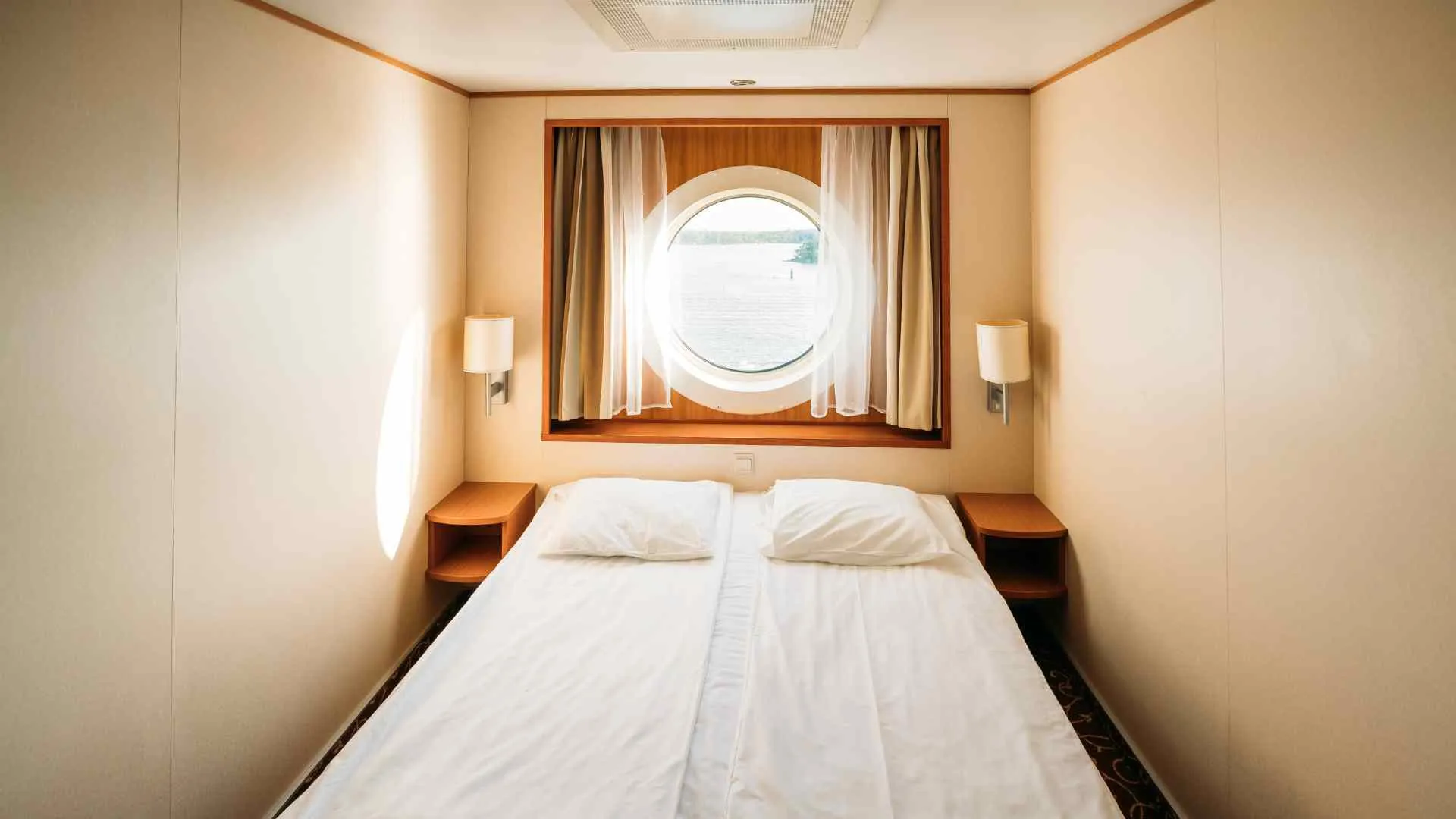
Oceanview Cabins: A Deeper Dive
The allure of the ocean is an intrinsic part of the cruising experience. Oceanview cabins, with their windows to the world outside, amplify this allure by offering passengers a personal vantage point.
But, as with all cabin types, nuances exist. Here’s how to discern between the different types of oceanview cabins and choose the best for your journey.
Standard Oceanview Cabins
Definition: These cabins come with a window or porthole, granting passengers a view of the outside.
- Finding the Best:
- Size and Shape: Some windows are larger, offering broader vistas, while others might be more circular or uniquely shaped. Consider your preference when booking.
- Deck Position: A cabin on a higher deck might offer less obstructed views, but remember, stability is often better on lower decks.
- What to Avoid:
- Cabins with “partially obstructed views.” This might mean a lifeboat or other equipment could be in your line of sight.
Panoramic Oceanview Cabins
Definition: These rooms offer floor-to-ceiling windows, giving an expansive view of the surroundings.
- Finding the Best:
- Positioning: Aim for cabins located at the ship’s front for the most unobstructed panoramic views.
- Glass Quality: Newer ships or recently refurbished ones tend to have clearer, cleaner windows. Check reviews for feedback.
- What to Avoid:
- Side-facing panoramic views might sometimes have obstructions, especially on larger ships. Always verify with the cruise line or check deck plans.
Obstructed Oceanview Cabins
Definition: As the name suggests, these cabins have some sort of obstruction, like lifeboats, blocking a clear view. They’re typically priced lower than standard oceanview cabins.
- Finding the Best:
- Degree of Obstruction: Some obstructions are minor, like a pole, while others, like a lifeboat, are more significant. Some passengers find value in a slightly obstructed view if the discount is substantial.
- Cabin Position: Often, cabins towards the center of the ship have fewer obstructions.
- What to Avoid:
- Assuming all obstructions are the same. Always inquire about the specific nature of the obstruction before booking.
With the ocean as your moving canvas, oceanview cabins certainly enhance the maritime experience. The trick lies in understanding the variations and being savvy when booking.
Armed with this knowledge, you can secure the best rooms on a cruise ship that let you greet the morning sun or bid farewell to a port in the most scenic way possible.

Balcony Cabins: Stepping into Open Air
Balcony cabins effortlessly merge the comforts of the indoors with the enchantment of the sea. With your private outdoor space, the ocean’s rhythm is just a sliding door away.
For many cruisers, this direct access to fresh air and unparalleled views is non-negotiable. However, there’s an art to selecting the best balcony cabin for your voyage. Let’s navigate through the various types and tips.
Standard Balcony Cabins
Definition: These cabins feature an attached private balcony, generally furnished with a couple of chairs and a small table.
- Finding the Best:
- Balcony Size: Not all balconies are equal. While the cabin’s interior might be consistent, balcony sizes can vary. Research or ask about dimensions.
- Deck Level: Higher decks often have more expansive views, but if you prefer reduced motion and quicker access to lower-deck amenities, a lower deck might be preferable.
- What to Avoid:
- Cabins directly under high-traffic areas, such as the pool deck, which might be noisy or lead to water dripping onto your balcony.
Extended or Oversized Balcony Cabins
Definition: These cabins boast larger-than-average balconies, providing more space to lounge, dine, or simply bask in the views.
- Finding the Best:
- Location: Often, the aft (rear) of the ship has cabins with extended balconies, offering panoramic views.
- Furniture: A larger balcony might come with upgraded furniture, like loungers. Check what’s included.
- What to Avoid:
- Paying a premium without verifying the actual size. Ensure the extra cost corresponds with a significantly larger outdoor space.
Cove Balcony Cabins
Definition: Situated closer to the waterline, these balconies are carved into the ship, offering a more enclosed, intimate feel.
- Finding the Best:
- Privacy: Due to their design, cove balconies often provide more privacy than traditional balconies.
- Proximity to Water: If you love being close to the ocean, these are ideal, but ensure you’re comfortable with the sound of waves.
- What to Avoid:
- If you’re prone to seasickness, being closer to the waterline might not be ideal, especially in rougher seas.
Spa Balcony Cabins
Definition: These cabins are typically located near the ship’s spa and may come with added wellness amenities or privileges.
- Finding the Best:
- Perks: Some spa balcony cabins offer complimentary spa access, treatments, or wellness-related seminars. Clarify what’s included.
- Ambiance: These cabins might feature more tranquil décor or aromatic amenities for relaxation.
- What to Avoid:
- Booking without understanding the spa privileges. Not all spa balcony cabins grant unlimited spa access.
The beauty of balcony cabins lies in their ability to provide a personal slice of the sea. For those who envision mornings sipping coffee as the sun rises or evenings gazing at stars, it’s an unmatched experience.
By understanding the different types and their subtleties, you’re well on your way to finding the best rooms on a cruise ship to elevate your oceanic adventure.
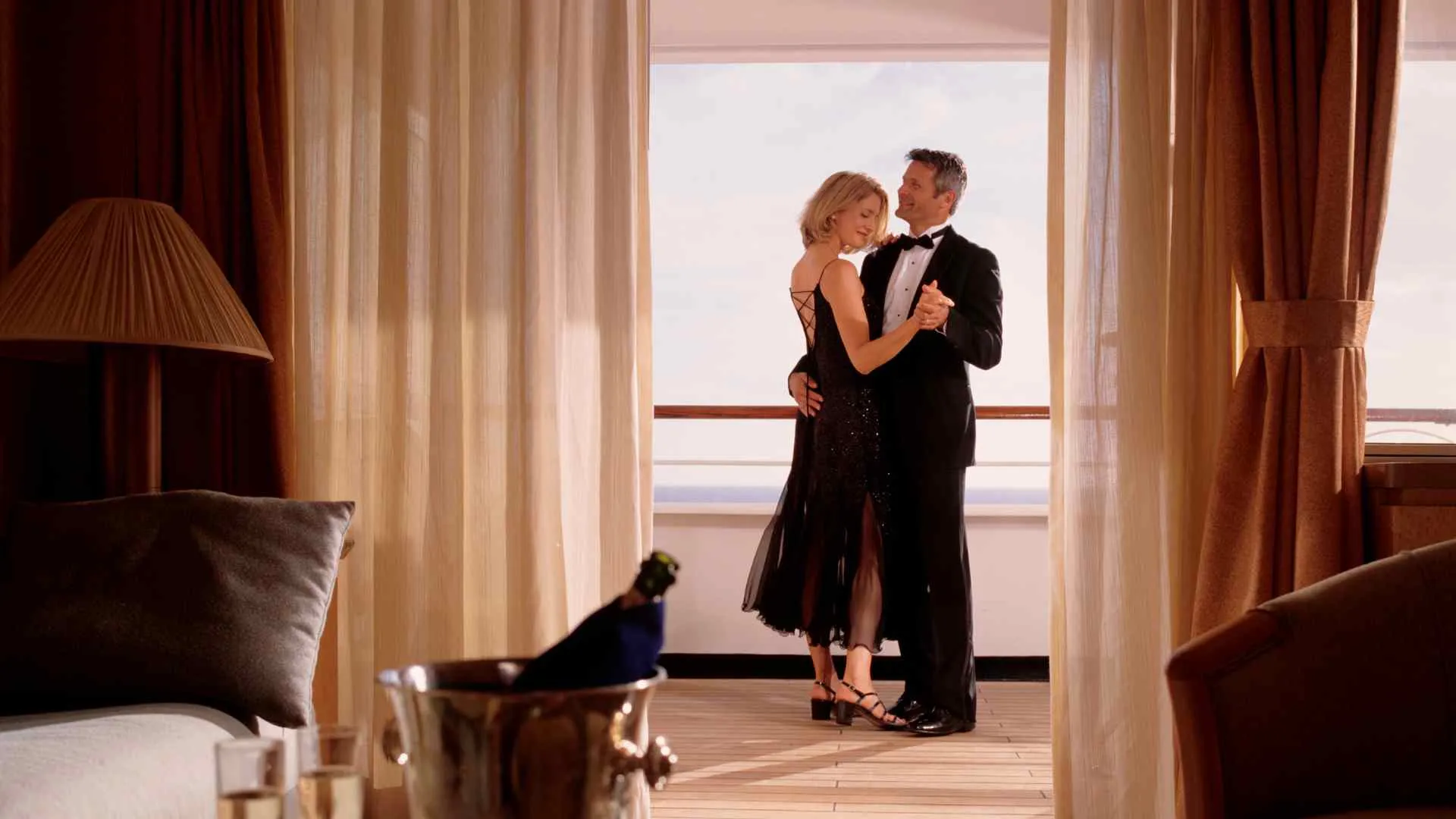
Suites: Embracing Maritime Luxury
For those seeking the pinnacle of onboard accommodation, suites embody opulence, space, and a host of exclusive perks. They transform a cruise journey into an ultra-luxe experience, where every detail caters to elevated comfort and indulgence.
However, within the realm of suites, variations abound. Here’s a breakdown to ensure you find the best suite to match your dream voyage.
Junior Suites
Definition: A step above standard balcony cabins, junior suites offer more space, often including a distinct seating area, and sometimes additional amenities.
- Finding the Best:
- Layout: Some junior suites boast a more open floor plan, while others might have partitioned areas. Depending on your preference, review layouts or photos.
- Bonus Amenities: Check if the suite comes with added perks like priority boarding, enhanced room service options, or concierge service.
- What to Avoid:
- Assuming it’s vastly larger than a balcony cabin. While more spacious, the difference might be subtle in certain cruise lines.
Grand Suites
Definition: Significantly larger than junior suites, these often include separate bedrooms, larger balconies, and more luxurious amenities.
- Finding the Best:
- Position on the Ship: Grand suites are often located in prime ship locations, ensuring the best views and reduced noise from public areas.
- Exclusive Access: Some ships offer exclusive lounges, dining areas, or pool decks for grand suite guests. Investigate any such privileges.
- What to Avoid:
- Overlooking the suite’s location. Even within the grand suite category, views and balcony sizes can vary.
Owner’s Suites
Definition: These are among the top-tier suites on a ship, often personalized with unique décor, multiple rooms, and a host of high-end amenities.
- Finding the Best:
- Personalized Service: Owner’s suites typically come with dedicated butler or concierge service. Ensure you’re aware of the level of personalization offered.
- Added Luxuries: From whirlpool tubs to walk-in closets, these suites might boast features not found in lower-tier suites.
- What to Avoid:
- Assuming all amenities are inclusive. Some services or dining options, even at this level, might incur additional charges.
Royal or Presidential Suites
Definition: The crème de la crème of cruise accommodations, these suites are often multi-room havens with expansive balconies, and they embody the epitome of maritime luxury.
- Finding the Best:
- Exclusive Perks: From private shore excursions to in-suite chef services, these suites might offer unparalleled experiences. Clarify the suite-specific offerings.
- Space: These suites might span multiple levels or offer expansive outdoor spaces, including hot tubs or private sunbathing areas.
- What to Avoid:
- Overlooking the suite’s position. Even at this tier, some suites might have preferable locations based on view, accessibility, or privacy.
Suites transform the cruising experience into a journey of unabashed luxury. The nuances between suite types can significantly influence your voyage’s ambiance and comfort.
By discerning these intricacies, you’ll be well-equipped to book the best rooms on a cruise ship, ensuring your maritime journey is as majestic as the vast oceans you traverse.
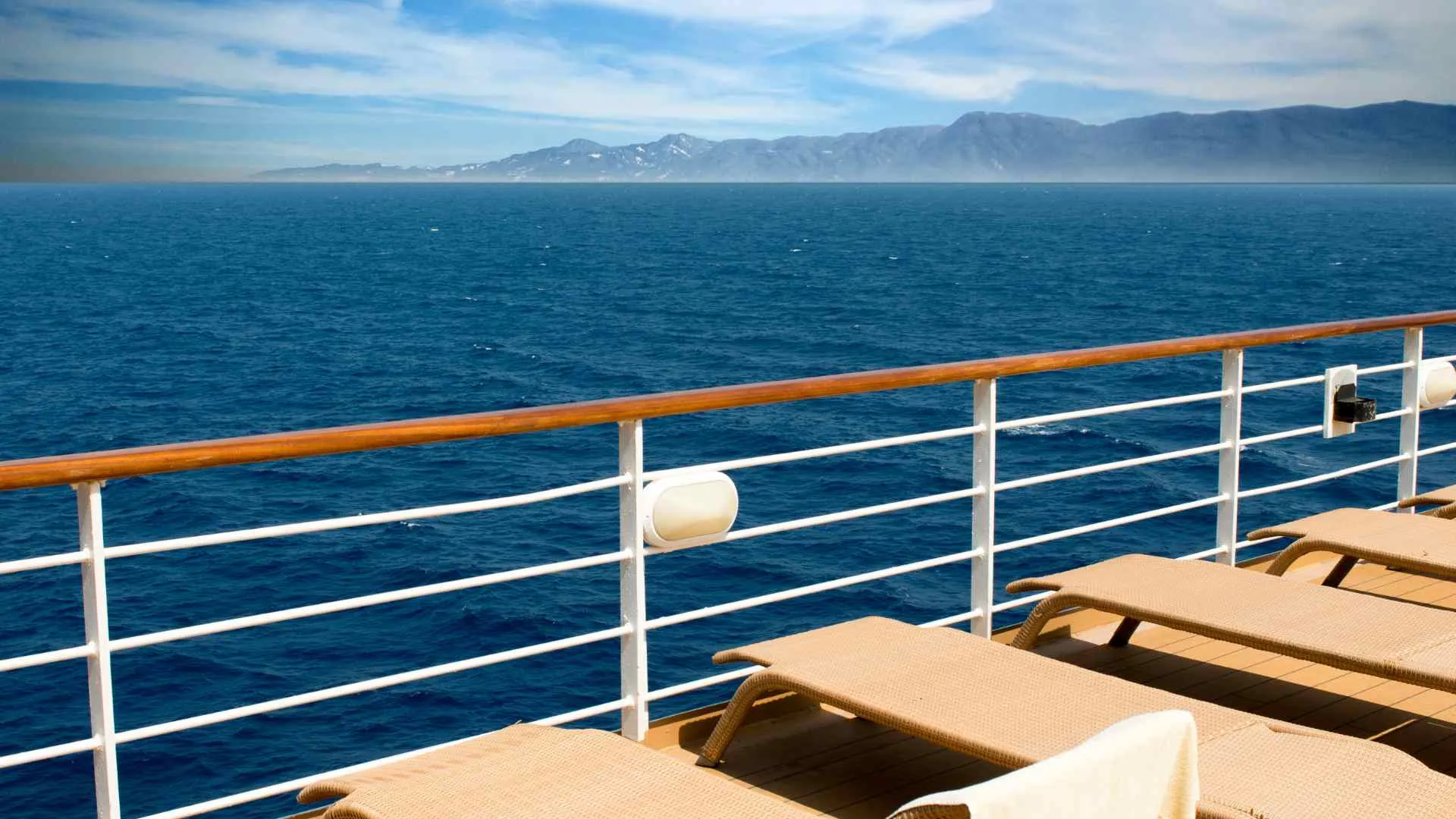
Location, Location, Location
While the type of room is undeniably crucial, its location on the ship can be equally influential in determining your cruising experience.
Just like in real estate, where a property’s value can soar or plummet based on its surroundings, the positioning of your cabin can have a profound impact on your journey. Here’s what you need to know to ensure you pick the best rooms on a cruise ship based on location.
The Importance of the Deck Level
The vertical placement of your room can influence several factors:
- Views: Higher decks often offer more sweeping, unobstructed views, especially if you’re overlooking a port or coastal landscapes.
- Motion: Lower decks, closer to the waterline, generally feel more stable. Those prone to seasickness might find these more comfortable.
- Accessibility: Depending on where you plan to spend most of your time, you might prefer being on a deck closer to certain amenities, be it dining areas, entertainment venues, or pools.
Forward, Midship, or Aft: What’s the Difference?
The ship’s horizontal position can also shape your experience:
- Forward (Front):
- Pros: Often quieter, with fewer passengers walking by. Some forward cabins might offer unique views, especially those with a forward-facing outlook.
- Cons: Might experience more motion, especially during rough seas.
- Midship (Middle):
- Pros: Typically the most stable part of the ship, reducing motion sickness chances. Central positioning means equidistant access to amenities both forward and aft.
- Cons: Can be busier, especially if near central elevators or stairwells.
- Aft (Rear):
- Pros: Provides unique aft-facing views, which are particularly mesmerizing when leaving ports. Some travelers also love the gentle hum of the ship’s engines as a soothing background noise.
- Cons: Might experience some vibrations from the ship’s propellers. Some aft locations require longer walks to main amenities.
Proximity to Ship Amenities
Consider what’s important to you:
- Entertainment Seeker: Being near the ship’s theater, lounges, or nightlife venues might be ideal.
- Food Lover: Proximity to main dining rooms, specialty restaurants, or buffets can be a bonus.
- Relaxation Chaser: If the spa, adult-only areas, or quiet lounges are your retreats, select a room nearby.
Tip: Always review the ship’s deck plans when booking. This way, you can avoid being directly under a noisy dance floor or right above a bustling kitchen.
Considering Potential Noise Sources
Every ship will have areas that are noisier than others:
- Avoid: Rooms near service areas, crew access points, or machinery spaces.
- Tread Carefully: Cabins near elevators or main stairwells can be convenient but might also mean more foot traffic and noise.
- Consider: If entertainment goes late into the night, rooms directly below or above such venues might not be the best for early sleepers.
Ultimately, location preferences can be highly individual. Some travelers prioritize tranquility, while others want to be in the heart of the action.
By understanding how each location can shape your experience, you’re better equipped to secure the best rooms on a cruise ship, ensuring a harmonious blend of rest, recreation, and remarkable views.
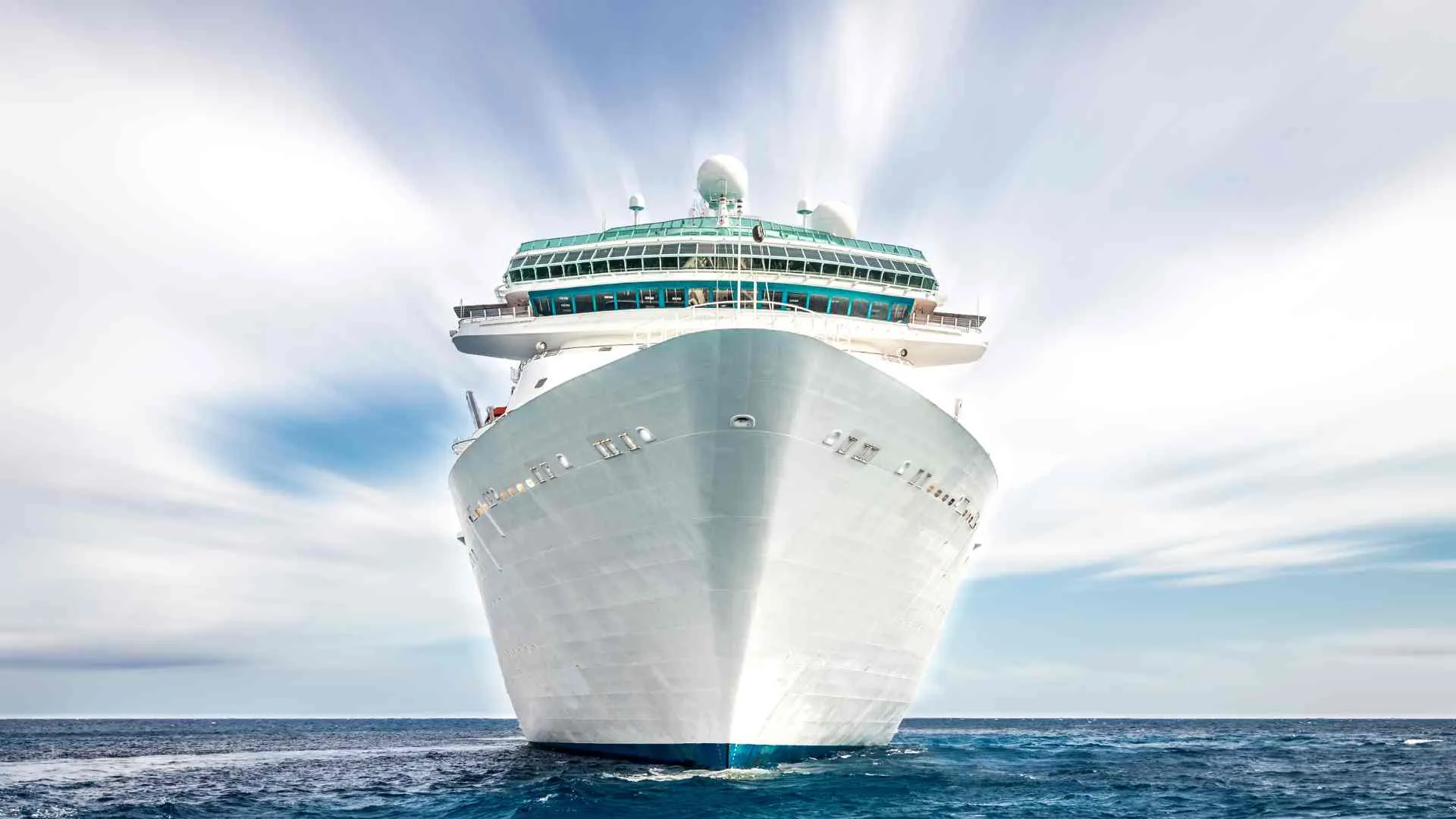
Special Rooms and Niche Cabins
Beyond the standard classifications of cruise cabins, there’s a world of specialized accommodations designed to cater to unique needs and preferences.
Whether you’re sailing solo or prioritizing wellness, there’s likely a cabin curated just for you. Let’s delve into these niche spaces and discover how they can elevate your cruising experience.
Solo Traveler Cabins
Definition: Tailored for single travelers, these cabins are optimized for individual use without the premium price tag of double-occupancy rooms.
- Benefits:
- Pricing: Often more economical for solo travelers than booking a standard cabin.
- Communal Areas: Some cruise lines offer exclusive lounges or gathering areas for solo cabin travelers, encouraging socialization.
- Considerations:
- Size: These cabins might be more compact. Ensure you’re comfortable with the dimensions before booking.
Family Suites and Adjoining Cabins
Definition: These are designed to accommodate larger groups or families, often featuring multiple rooms or interconnecting doors.
- Benefits:
- Space: More room for families to spread out, often with separate sleeping areas for adults and kids.
- Convenience: Adjoining cabins allow families or groups to stay close while maintaining some privacy.
- Considerations:
- Booking Early: These specialized cabins can fill up quickly, especially during school holidays or peak travel times.
Spa Cabins and Wellness-Themed Rooms
Definition: Cabins situated near the spa or designed with a focus on wellness, often including amenities or perks centered on relaxation and health.
- Benefits:
- Amenities: Might include items like aromatherapy diffusers, premium bath products, or yoga mats.
- Exclusive Access: Some come with complimentary spa access, free classes, or discounted treatments.
- Considerations:
- Location: While being near the spa is convenient for treatments, ensure you’re okay with the potential foot traffic or ambient noise.
Themed Suites
Definition: Cabins or suites inspired by specific themes, such as a particular artist, luxury brand, or cultural motif.
- Benefits:
- Unique Décor: These suites offer a distinctive ambiance, making your stay memorable.
- Exclusive Merchandise or Experiences: Depending on the theme, you might receive limited-edition items or access to special events onboard.
- Considerations:
- Price: Themed suites are often premium-priced due to their unique nature. Ensure the theme resonates with you enough to justify the added cost.
Navigating the myriad of cabin choices on a cruise ship can feel daunting, but remember, this breadth of options means there’s likely a perfect room for your unique needs.
By familiarizing yourself with these special rooms and niche cabins, you’re one step closer to ensuring your maritime abode is one of the best rooms on a cruise ship for your journey’s goals.

Consideration Factors When Booking a Room
Booking the perfect room on a cruise ship isn’t just about choosing between an inside cabin or a suite; it’s a culmination of various factors that align with your travel priorities, habits, and comfort levels.
As you set sail (figuratively) through the booking process, here are some pivotal considerations to weigh to ensure you secure the best room for your adventure.
Duration of the Cruise
The length of your voyage can significantly influence your room choice:
- Short Getaways: For brief trips, you might be more willing to compromise on room size or amenities, knowing you’ll be back on land soon.
- Extended Voyages: For longer journeys, comfort becomes paramount. An ample-sized room or one with a balcony might be worth the investment for the extended time at sea.
Personal Preferences and Habits
Your individual quirks and habits play a role:
- Night Owls vs. Early Birds: If you’re up late on your fun cruise enjoying onboard entertainment, being near venues might be convenient. Conversely, if you’re an early riser, a quieter, forward-located cabin might be your haven.
- Social Butterfly vs. Privacy Seeker: If you love mingling, a cabin near social hubs might be ideal. If solitude is your goal, look for more secluded cabin locations.
Budget Considerations
Financial factors are, understandably, significant:
- Room Type vs. Onboard Experiences: Determine where you’d like to allocate more of your budget. Would you prefer a lavish room or more funds for excursions, dining, and onboard activities?
- Hidden Fees: Be aware of potential added charges, like service fees, that might not be immediately evident when booking.
Seasickness and Motion Sensitivity
If you’re prone to motion sickness, review our cruise cabins to avoid:
- Deck Level: Lower decks, closer to the center of the ship, typically experience less movement.
- Cabin Position: Midship cabins can offer more stability compared to those at the forward or aft.
Special Needs or Requirements
Ensure the cruise line can accommodate any specific needs:
- Mobility Concerns: If you require an accessible room, ensure it’s equipped with necessary features and is conveniently located.
- Dietary or Medical Needs: While not directly related to room choice, ensuring the cruise can cater to specific health needs is crucial. This might influence your decision on a particular ship or cruise line.
Selecting the ideal room is akin to piecing together a puzzle; every factor plays its part in creating the full picture.
By considering these elements and weighing them against your personal priorities and desires, you’ll be better positioned to choose not just a good room, but one of the best rooms on a cruise ship for your unique journey.

Top Tips for Getting the Best Deal on the Best Room
Who doesn’t love a good deal, especially when it comes to travel? Securing the best rooms on a cruise ship doesn’t always have to come with a hefty price tag.
With some savvy strategies and a bit of flexibility, you can enjoy premium accommodations without breaking the bank. Here are some top tips to get the most bang for your buck.
Booking Early vs. Last-Minute Deals
- Early Bird Specials: Many cruise lines offer discounts or additional perks for those who book well in advance. This can also give you the best selection of rooms.
- Last-Minute Bargains: Cruise lines want to fill their ships. If you’re flexible with dates and room types, you might snag substantial discounts by booking close to the departure date.
Off-Peak vs. Peak Season
- Travel During Shoulder Seasons: These are the periods right before or after peak seasons. You can enjoy milder weather, fewer crowds, and often better deals.
- Avoid School Holidays: Prices often surge during school breaks. If you’re not bound by school schedules, choose dates outside these periods for potential savings.
Utilizing Travel Agents and Cruise Consultants
- Insider Knowledge: Experienced agents often have access to exclusive deals or can advise on the best promotions based on your preferences.
- Group Discounts: If you’re traveling with a large group or organizing an event, agents might secure group rates or added perks.
Joining Loyalty Programs
- Earn Points for Perks: Regular cruisers can accumulate points with specific cruise lines, leading to cabin upgrades, onboard credits, or other benefits.
- Exclusive Deals: Loyalty members often get first dibs on promotions or special rates not available to the general public.
Monitoring Promotions and Flash Sales
- Sign Up for Newsletters: Cruise lines often send out deals to their subscribers before advertising them widely.
- Follow on Social Media: Cruise lines might announce flash sales or special promotions on their social channels.
Consider Repositioning Cruises
- Unique Routes, Lower Prices: These cruises occur when a ship relocates to a different region for a new season. They can offer unique itineraries and often come with reduced rates.
Cabin Guarantees
- Flexible Savings: Instead of choosing a specific room, you pick a cabin category (like a balcony room). The cruise line then selects your exact room, often leading to discounted rates. The gamble can result in upgrades, but exact placement is left to chance.
Armed with these strategies, the best rooms on a cruise ship become not just a dream but a tangible, affordable reality. Remember, the key is a blend of flexibility, timing, and doing a bit of homework to ensure you’re sailing in style without unnecessary expenditure.
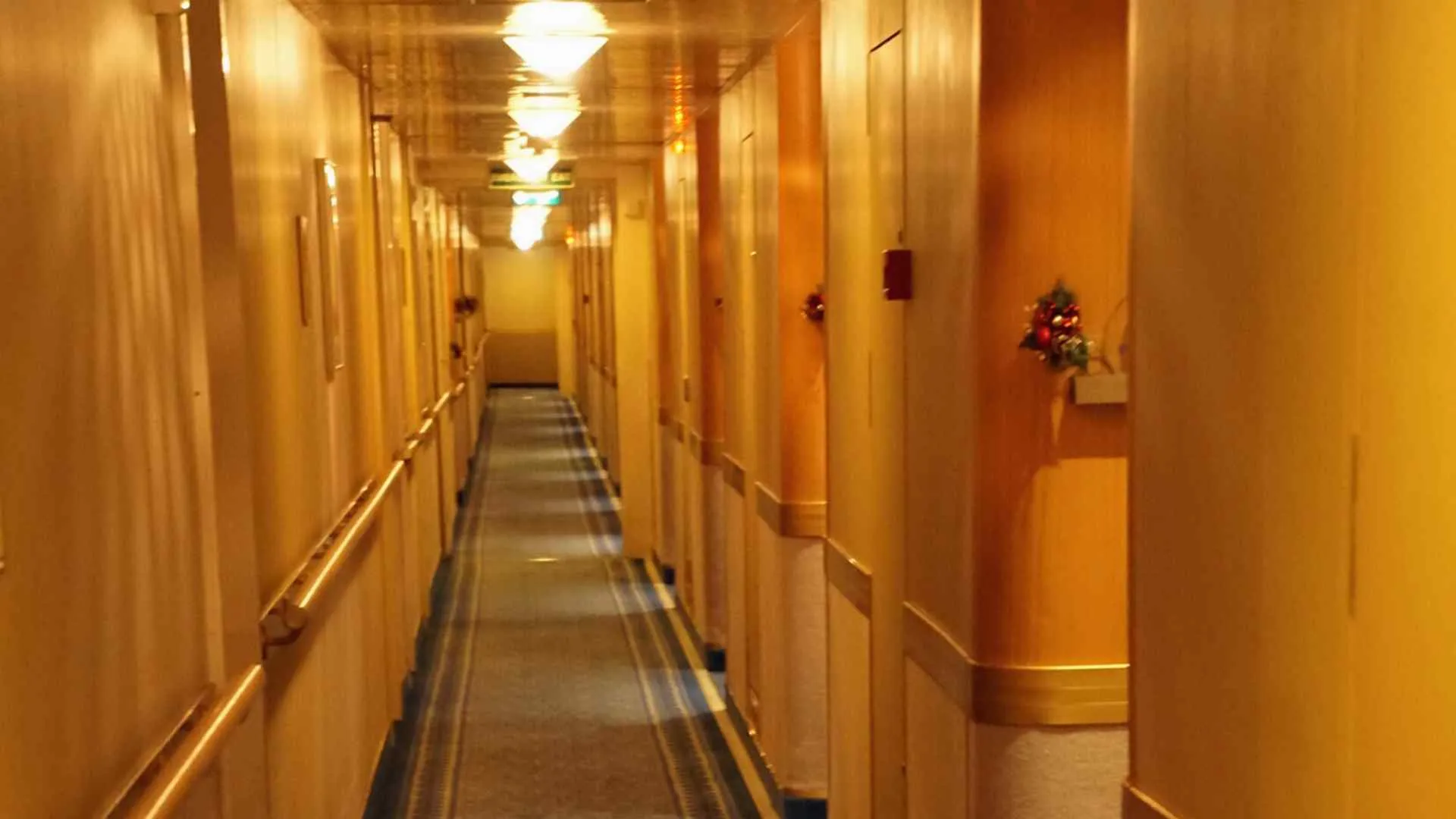
Common Misconceptions and Myths about Cruise Rooms
In the vast sea of information about cruise travel, myths and misconceptions can often blur the waters, leading potential cruisers astray.
When it comes to selecting the best rooms on a cruise ship, it’s crucial to separate fact from fiction. Here are some common myths debunked to set the record straight.
Myth 1: Inside Cabins are Always Dark and Claustrophobic
Reality: Modern cruise ships often design their inside cabins to optimize space and comfort. While they lack windows, innovative design, ambient lighting, and even virtual balconies on some newer ships can make these rooms feel spacious and welcoming.
Myth 2: Suites are the Only Way to Experience Luxury
Reality: While suites offer a premium experience, many modern balcony or oceanview cabins also provide plush amenities, elegant decor, and comfortable furnishings. It’s about finding the right balance between luxury and budget.
Myth 3: Lower Deck Cabins are Inferior
Reality: Cabins on lower decks can offer several advantages, including less motion (ideal for those prone to seasickness), faster disembarkation at ports, and often, lower prices.
Myth 4: All Balconies Offer Complete Privacy
Reality: While balconies do provide private outdoor space, they might not always be entirely secluded. Depending on the ship’s design, some balconies might be overlooked by others or be more exposed. It’s essential to check deck plans and cabin positioning.
Myth 5: Cabins Near Elevators are Incredibly Noisy
Reality: Modern cruise ships are constructed with noise-reduction techniques. While there might be increased foot traffic near elevators, many travelers find the convenience outweighs any minimal noise.
Myth 6: Changing Rooms During a Cruise is Impossible
Reality: If you’re unsatisfied with your room due to a valid concern (like noise or malfunctioning amenities), cruise staff will often do their best to accommodate a room change, provided there’s availability.
Myth 7: The Size and Layout of Cabins within the Same Category are Identical
Reality: Even within the same category, there can be variations in square footage, layout, or balcony size. Always verify specific details or check deck plans.
Myth 8: Oceanview Cabins Guarantee Unobstructed Views
Reality: Not all oceanview cabins guarantee clear vistas. Some might have lifeboats or parts of the ship’s structure slightly obstructing the view. It’s crucial to check and perhaps consider “obstructed view” cabins for discounts if the obstruction is minor.
Selecting a room on a cruise ship can be daunting, especially with persistent myths clouding judgment. By dispelling these misconceptions, you can approach your booking with clarity, ensuring you secure one of the best rooms on a cruise ship that aligns perfectly with your expectations and desires.
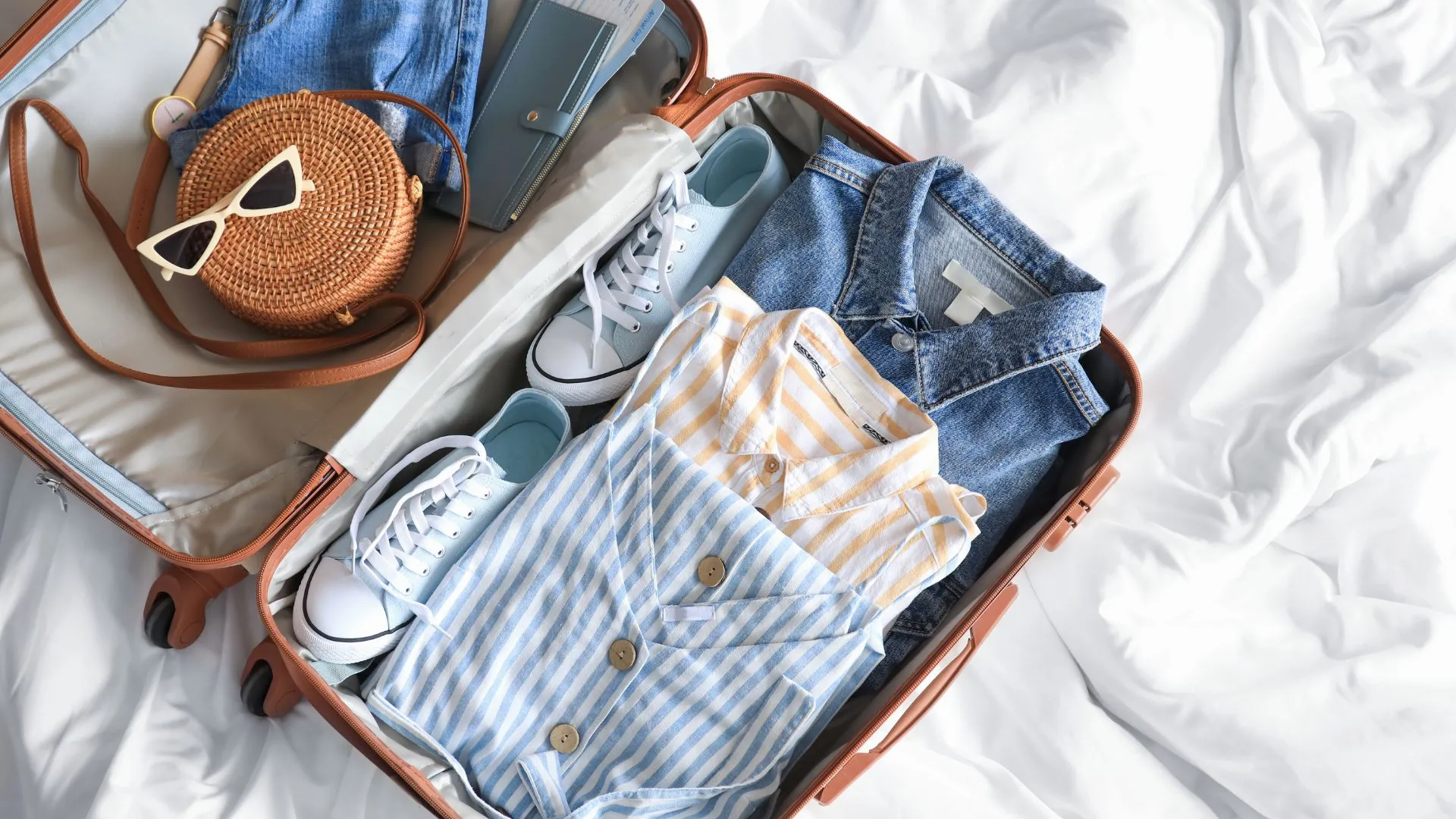
Packing Tips for Your Chosen Room
Whether you’re in a cozy inside cabin or a sprawling suite, maximizing your space and ensuring you have everything you need is essential.
Packing for a cruise is an art form—one that balances preparedness with practicality. Make sure to review our cruise packing list and here are some tailored cruise tips to make the most of your chosen room.
For All Rooms:
- Over-the-Door Organizer: These hanging pockets can be a lifesaver for storing small items like toiletries, sunglasses, or daily itineraries. They help keep surfaces clutter-free.
- Magnetic Hooks: Since most cruise ship walls are metallic, magnetic hooks can be handy for hanging hats, bags, or daily schedules.
- Non-slip Hangers: Cruise ship closets are generally equipped with hangers, but having a few non-slip ones can ensure your clothes stay put even if the seas get choppy.
Inside Cabins:
- Nightlight: Since these rooms can get very dark, packing a small nightlight can help you navigate if you need to get up during the night.
- Space-saving Storage: Collapsible storage cubes or under-bed storage can help organize your belongings and make the most of limited space.
Oceanview Cabins:
- Lens Wipes: Keep your window or porthole clear and smudge-free to enjoy those ocean views.
- Binoculars: Especially if you’re keen on spotting marine life or distant landscapes.
Balcony Cabins:
- Balcony Clips: These clips can secure towels or clothing to the balcony chairs or railings, preventing them from flying away.
- Ambiance Lights: Battery-operated fairy lights can add a touch of magic to evening balcony moments. Ensure they are soft and non-disruptive to fellow passengers.
Suites:
- Entertainment Packs: If you have a living area, consider bringing board games, a deck of cards, or streaming devices to make the most of your entertainment system.
- Door Decorations: Some cruisers like to personalize their suite doors (especially for celebrations). Just ensure they are easily removable and don’t damage the door.
Additional Tips:
- Power Strip (Non-Surge): Cabins often have limited outlets. Bringing a non-surge power strip can ensure all your devices stay charged. Note: Ensure it’s cruise-compliant; surge protectors are generally not allowed.
- Scented Sachets: Keep your room smelling fresh. Opt for mild scents to avoid overwhelming small spaces or causing discomfort to those with sensitivities.
- Portable Fan: For those who prefer a cooler room or white noise while sleeping.
- Drying Line: Useful for hanging wet swimwear or hand-washed items. Some are designed to attach to the shower.
Packing smartly for your cruise room isn’t just about remembering your swimsuit and sunscreen—it’s about optimizing your onboard living space for comfort and convenience.
By tailoring your packing list to your specific room type and including a few clever extras, you’ll be set to fully enjoy every moment of your maritime adventure, both onboard and ashore.

Conclusion
Embarking on a cruise is more than just a journey—it’s an immersive experience that melds adventure with comfort. The heart of this comfort lies in your chosen room, a personal sanctuary amidst the vast expanse of the sea.
Whether you’re drawn to the intimate coziness of an inside cabin or the grandeur of a luxurious suite, the key is knowledge. By understanding the nuances of each room type, considering prime locations, debunking myths, and packing with purpose, you’re well-equipped to make informed decisions.
So, as you set sail, know that the best rooms on a cruise ship await, promising memories that will last a lifetime.
FAQs on Best Rooms on a Cruise Ship
1. What is the quietest room on a cruise ship?
Answer: The quietest rooms are usually located midship, away from high-traffic areas such as elevators, stairwells, or service areas. Cabins on decks situated between other cabin decks (as opposed to being beneath public areas or restaurants) are often quieter as well.
2. Are higher decks better on cruise ships?
Answer: Higher decks often provide better views and are closer to many amenities like pools or observation decks. However, they might experience more movement, potentially causing seasickness. The best deck is subjective and depends on individual preferences and priorities.
3. Do all cruise ship rooms have windows?
Answer: No, inside cabins typically lack windows. Oceanview cabins have windows or portholes, while balcony cabins and suites have sliding doors to the outside.
4. Is it worth getting a balcony on a cruise?
Answer: It depends on personal preferences. Many cruisers value the privacy, fresh air, and views a balcony offers, especially on scenic routes. However, if you plan to spend most of your time exploring the ship or in port, an inside or oceanview cabin might suffice.
5. Can I choose my specific cabin when booking?
Answer: Yes, many cruise lines allow you to select a specific cabin when booking. However, there’s also a “guarantee cabin” option where you pick a category (like a balcony room), and the cruise line assigns a specific cabin, sometimes at a lower rate.
6. Are cruise ship rooms claustrophobic?
Answer: Modern cruise cabins, even inside ones, are designed to maximize space and comfort. While they might be compact, clever design, lighting, and amenities often prevent a claustrophobic feel. If you’re concerned, consider a room with a window or balcony.
7. What do “port side” and “starboard side” mean?
Answer: These are nautical terms. “Port side” refers to the left side of the ship when facing forward, while “starboard side” refers to the right. Some cruisers have preferences based on the ship’s itinerary and potential views.
8. Do I need to tip room stewards on a cruise?
Answer: Many cruise lines automatically add gratuities for room stewards to your onboard account. However, if you receive exceptional service, additional tipping is at your discretion. Always check the cruise line’s tipping policy.
9. Are midship cabins more expensive?
Answer: Not necessarily. While midship cabins are often prized for their stability and central location, their price largely depends on the cruise line, the specific ship, and the deck level. Sometimes, they might carry a slight premium, but prices are typically based more on cabin type (e.g., inside, balcony) than exact location.
10. Is there Wi-Fi in cruise ship rooms?
Answer: Most modern cruise ships offer Wi-Fi, which is accessible from the rooms. However, the speed, quality, and cost can vary widely among cruise lines. It’s advisable to check the ship’s Wi-Fi packages and rates in advance.
11. How safe are balcony rooms for children?
Answer: Cruise ships are designed with safety in mind. Balcony railings are typically high and robust, making it difficult for children to climb. However, it’s essential always to supervise children and ensure they don’t climb on furniture or the railings.
12. Are cruise ship room sizes standardized?
Answer: No, room sizes can vary significantly between cruise lines and even among ships within the same line. It’s essential to check the specific square footage or layout of a room before booking, especially if space is a priority.
13. Can I bring my own food and drink into my cruise room?
Answer: Cruise lines have varying policies. Most allow you to bring limited amounts of non-alcoholic beverages and snacks. However, bringing alcohol onboard might incur a corkage fee or be prohibited. Always check the cruise line’s specific policy.
14. Do cruise ship rooms have refrigerators?
Answer: Many modern cruise cabins, especially higher categories like balcony rooms or suites, come equipped with mini-fridges. However, it’s good to verify in advance, especially if you have medications or specific items that need refrigeration.
15. How often are cruise rooms cleaned?
Answer: Typically, cruise ship rooms are cleaned at least once a day, with evening turndown service also offered. Many cruise lines provide twice-daily cleaning, ensuring rooms are refreshed both in the morning and evening.
16. What’s the difference between “obstructed” and “unobstructed” views?
Answer: An “obstructed” view means something might block the view from your window or balcony, like a lifeboat or support beam. “Unobstructed” views have no such blockages, offering clear vistas.
17. Are there laundry facilities in cruise ship rooms?
Answer: Most standard cruise cabins don’t have in-room laundry facilities. However, many cruise ships offer self-service laundromats or laundry services for a fee. Some higher-end suites might include complimentary laundry service as a perk.
18. Can I customize my room decor or setup?
Answer: While cruise lines allow minor personalization, like door decorations or setting up personal items, they typically don’t permit major alterations, adhering items to walls, or moving large furniture pieces. It’s always essential to respect the cruise line’s policies and ensure any decor is easily removable without damage.
